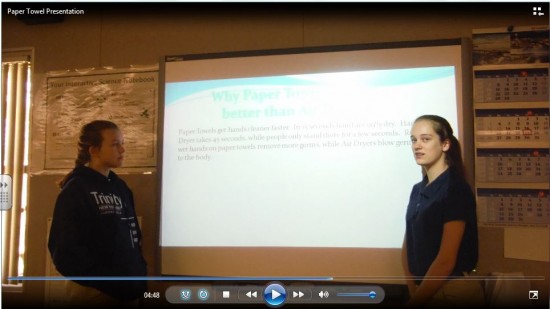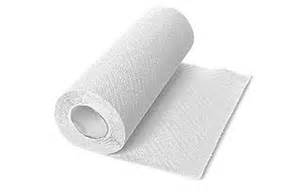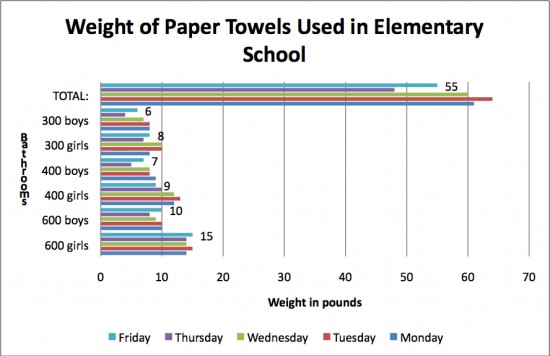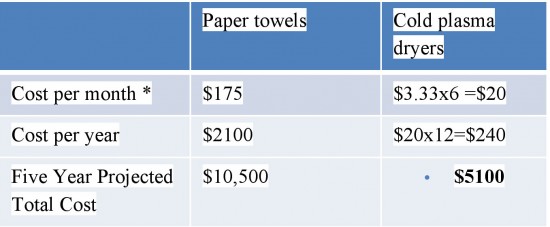Environmental Education: The Science of Learning and Doing
by Cecelia Bosma
Trinity Lutheran School
Litchfield, Arizona
 e live on a planet with limited resources that are often consumed without caution. Finding ways to engage students in pro-environmental behaviors that conserve these limited resources rather than take them for granted is a priority for environmental educators. The human population also needs to work on understanding the benefits and risks we take with our daily behavior. Conserving the use of paper towels at home and in public is one easy pro-environmental behavior that will have a positive impact on the environment. Paper towels do not just use up trees, they also require large amount of water for production and they end up in landfills which generates pollution as they slowly decompose. However there are numerous alternatives to using paper towels at home and at school. These alternatives are efficient effective and financially thrifty. Often times conservation practices are rejected because they are time consuming and or costly. Alternatives to paper towels are neither. The financial benefit is an incentive for people that don’t relate to the environmental impact of using paper towels.
e live on a planet with limited resources that are often consumed without caution. Finding ways to engage students in pro-environmental behaviors that conserve these limited resources rather than take them for granted is a priority for environmental educators. The human population also needs to work on understanding the benefits and risks we take with our daily behavior. Conserving the use of paper towels at home and in public is one easy pro-environmental behavior that will have a positive impact on the environment. Paper towels do not just use up trees, they also require large amount of water for production and they end up in landfills which generates pollution as they slowly decompose. However there are numerous alternatives to using paper towels at home and at school. These alternatives are efficient effective and financially thrifty. Often times conservation practices are rejected because they are time consuming and or costly. Alternatives to paper towels are neither. The financial benefit is an incentive for people that don’t relate to the environmental impact of using paper towels.
 Last fall, I designed a project to engage my eighth grade science class in a meaningful scientific inquiry project that assisted in deepening students’ understanding of the importance of conservation action through environmental education. The project action focused on eliminating paper towels in school bathrooms. There are many environmental benefits to reducing the amount of paper towels manufactured. One benefit is the reduction of trash in landfills because generally bathroom paper towels cannot be recycled. Another benefit is the reduction of chemicals leaching back into our soil from decomposing paper towels. This in turn saves trees from being processed into paper towels. Environmental benefits are also found in the amount of water consumed in the manufacturing of paper towels, and the reduced amount of fuel burned transporting paper towels.
Last fall, I designed a project to engage my eighth grade science class in a meaningful scientific inquiry project that assisted in deepening students’ understanding of the importance of conservation action through environmental education. The project action focused on eliminating paper towels in school bathrooms. There are many environmental benefits to reducing the amount of paper towels manufactured. One benefit is the reduction of trash in landfills because generally bathroom paper towels cannot be recycled. Another benefit is the reduction of chemicals leaching back into our soil from decomposing paper towels. This in turn saves trees from being processed into paper towels. Environmental benefits are also found in the amount of water consumed in the manufacturing of paper towels, and the reduced amount of fuel burned transporting paper towels.
Getting started on an inquiry project that is focused on building environmental knowledge through conservation action on the school campus can be a challenge. I have been working middle school students on various inquiry projects to build environmental knowledge for several years. Each time I start a project I am learning right along with my students. This project was no exception. Sharing ideas about inquiry and lessons that motivate students to learn and build knowledge is how we as teachers can help each other build stronger lesson plans that benefit our students and communities.
Project Inspiration
Educating adolescents about the impact they have on their environment is necessary for nurturing lifelong environmental stewardship (Nancy & Kristi, 2006). In the last twenty years, environmental education has been gaining a stronger foothold in classrooms across America (Stevenson, Peterson, Bondell, Mertig, & Moore, 2013). The purpose of environmental education is to teach students how to make responsible decisions, using critical thinking in order to take action to maintain or improve our environment (Short, 2010). Educators should encourage even small steps toward environmental conservation, as they are building blocks to lifetime environmental conservation action (Short, 2010). Accordingly, the primary goal of environmental education is to instill knowledge that leads to pro-environmental actions and behaviors for individuals, groups and society (Heimlich, 2010). I have found that engaging the learners in hands on actionable learning has a positive effect on the outcome of environmental education.
The burgeoning population of planet Earth has brought about observable changes in the environment both in populated and unpopulated regions of the world (Short, 2010). Scientists have observed these drastic changes in the form of melting ice caps, ozone depletion, deforestation and global warming, all of which can be attributed to human actions (Tidball & Krasny, 2010). Therefore, it is society’s responsibility to take action to improve the current environmental status that threatens the very existence of humans (Stevenson et al., 2013).
Additionally, it is important to incorporate positive actions into environmental education (Tidball & Krasny, 2010). Instead of focusing on what is wrong with our environment. Students are motivated by positive changes that help our environment such as recycling. Inquiry style learning is one way to incorporate positive action. Increasing environmental knowledge is a crucial part of environmental education (Grodzińska-Jurczak, Bartosiewicz, Twardowska, & Ballantyne, 2003). This project incorporated the inquiry process into the environmental education program. The students construct their learning by observing, asking questions and problem solving (Crawford, 2000). The inquiry process is a way for students to do science like a real scientist. Educating school children about environmental concerns now will promote action in the future (Evans et al., 1996).
The Project
A class of twelve eighth grade students took part in the paper towel conservation inquiry project. The project began with students watching the video that inspired me “How to use a paper towel” (Smith, 2012). Upon completion of the video, students were asked what they thought of the video and if they thought there were other ways that we could conserve paper towels in the bathrooms on our campus. Following the video students took a trip to the boys’ and girls’ bathrooms nearest to our classroom. Science class is at the end of the day, and students observed the piles of used paper towels in the garbage and on the ground.
They were challenged to develop a plan for measuring the volume of paper towels that were used daily for a week. Students worked in pairs to identify a plan which was presented the next day in class. Students then voted on the plan they thought would work the best and took steps to put it into action. One students brought in a scale from home and others created a data sheet for recording the measurements taken daily of the weight of paper towels used in each bathroom.
The students tracked the amount, in pounds, of paper towels used in the 3 sets of boys’ and girls’ bathrooms for 5 days. This data was calculated and graphed to demonstrate the amount of paper towels that our school is disposing into the landfill each day. A total of 288 pounds of paper towels are thrown in the trash each week from the collective school bathrooms (figure 1). Students contacted the person on staff who handles the ordering of paper towels to determine that the school spends about $350.00 on paper towels each month. This information was tabulated into the final graph that compared the expense of paper towels versus the expense hand dryers (figure 2). The graph shown in figure 1 and 2 were developed by students; while it could be perfected it is meant to demonstrate the capabilities of middle school students. Upon completing the charts students noticed that the older students used considerably more paper towels than younger students did.
Students brainstormed alternative ideas to using paper towels. They researched hand dryers, cotton towel dispensers and looked at the practicality of using personal towels. After researching each option, they used the data they collected on alternatives to paper towels to create a presentation to share with fellow students, parents and the church board who has a strong influence on decision making changes. The conclusion of the study resulted in the student recommending the installation of new efficient hand dryers that dry hands in 12 seconds or less. As the students pointed out in their presentation the machines are also designed to kill germs in the air and on the skin (Gagnon, 2007).
 The presentation was videotaped and posted on the school website. Posting the video required getting permission from all of the parents. This was worthwhile effort because the students were then able to share what they had learned accomplished and produced with their own community of friends and neighbors. This made it possible to spread the idea of replacing paper towels with hand dryers to the larger community outside of our school.
The presentation was videotaped and posted on the school website. Posting the video required getting permission from all of the parents. This was worthwhile effort because the students were then able to share what they had learned accomplished and produced with their own community of friends and neighbors. This made it possible to spread the idea of replacing paper towels with hand dryers to the larger community outside of our school.
The final piece of this project was to present a written proposal to the Board of Directors for consideration. Students were given the task and some guidelines and they had to collaborate and compromise to develop a well written proposal that included their research and data results. The objective of the assignment was to persuade the board to approve the installation of hand dryers in the bathroom. The proposal was completed and presented, and is now being considered for implementation.
Action and Reflection
The benefit of inquiry learning is that it provides a method for gaining deeper knowledge about a subject, in this case environmental education, and it also builds students skills in problem solving and analysis. This project provided students the opportunity to conduct science like a scientist. They observed and questioned. Then they looked for alternatives, conducted research, devised an action plan and carried out an investigation. The final part of the project included compiling their findings and presenting to decision makers. Encouraging and guiding students to learn about their environment and then to take action is taken to authentic level when it involves real and actionable projects. It is my hope that the board finds merit in the study and takes the necessary steps to change to electric hand dryers. This action will mitigate the burden, the use of paper towels, puts on our environment.
I know that this project was beneficial in bolstering students’ knowledge of environmental issues. Throughout the project students took ownership of each step and worked diligently to complete the work. The following are several comments from students at the end of the project.
“I liked being able to go outside for science.”
“I hope that hand dryers are installed in the bathrooms”
“I worked really hard on this project because it might be good for our school”
This paper towel action-centered conservation project works to build students conservation and knowledge that works to promote continued conservation action (Stevenson et al., 2013). Schools are looking for ways to keep the material fresh and relevant for the students incorporating inquiry science works towards that goal. We have a planet with limited resources, and an economic system that often ignores that fact. As time goes by the need for action is even more crucial for the survival of all of us. Paper towel reduction is one idea that students can be engaged in environmental education. We have to find ways for students to not only learn about importance of caring for our environment but that knowledge must lead to continued environmental action for the objective to be met.
As a teacher, focusing on improving techniques to guide inquiry learning, leads to discovering ways to make projects authentic and real. Utilizing inquiry in environmental education provides students an enriching learning environment. This is my story of a journey to use inquiry as a catalyst for environmental change. Embrace your story.
Bibliography
Crawford, B. A. (2000). Embracing the essence of inquiry: new roles for science teachers. Journal of Research in Science Teaching, 37(9), 916-937. doi: 10.1002/1098-2736(200011)37:93.0.CO;2-2
Evans, S. M., Gill, M. E., & Marchant, J. (1996). Schoolchildren as educators: The indirect influence of environmental education in schools on parents’ attitudes towards the environment. Journal of Biological Education, 30(4), 243-248. doi:10.1080/00219266.1996.9655512
Gagnon, D. (2007). Paper Trail. American School & University, 80(1), 30.
Grodzińska-Jurczak, M., Bartosiewicz, A., Twardowska, A., & Ballantyne, R. (2003). Evaluating the impact of a school waste education programme upon students’ parents’ and teachers’ environmental knowledge, attitudes and behaviour. International Research in Geographical and Environmental Education, 12(2), 106-122. doi:10.1080/10382040308667521
Heimlich, J. E. (2010). Environmental education evaluation: reinterpreting education as a strategy for meeting mission. Evaluation and Program Planning, 33, 180-185. doi: 10.1016/j.evalprogplan.2009.07.009
Short, P. C. (2010). Responsible environmental action: its role and status in environmental education and environmental quality. Journal of Environmental Education, 41(1), 7-21. doi: 10.1080/00958960903206781
Smith, J. (2012, March). How to use a paper towel. Retrieved from: https://www.ted.com/talks/joe_smith_how_to_use_a_paper_towel
Stevenson, K. T., Peterson, M. N., Bondell, H. D., Mertig, A. G., & Moore, S. E. (2013). Environmental, institutional, and demographic predictors of environmental literacy among middle school children. PLoS ONE, 8(3), 1-11. doi: 10.1371/journal.pone.0059519
Tidball, K. G., & Krasny, M. E. (2010). Urban environmental education from a social-ecological perspective: conceptual framework for civic ecology education. Cities and the Environment(1). Retrieved From: http://digitalcommons.lmu.edu/cate/vol3/iss1/11/
Wells, N. M., & Lekies, K. S. (2006). Nature and the life course: Pathways from childhood nature experiences to adult environmentalism. Children Youth and Environments, 16(1), 1-24.



